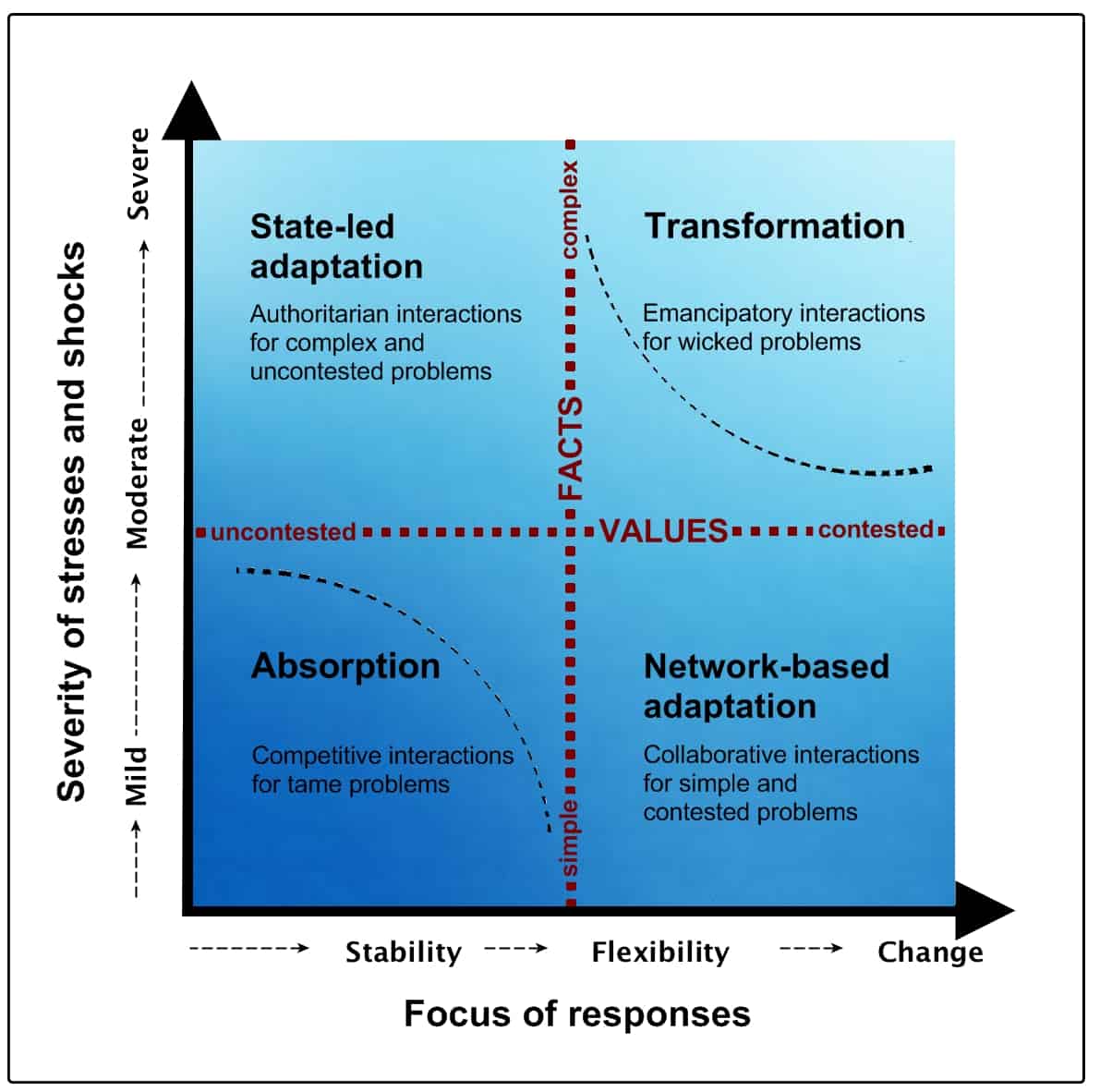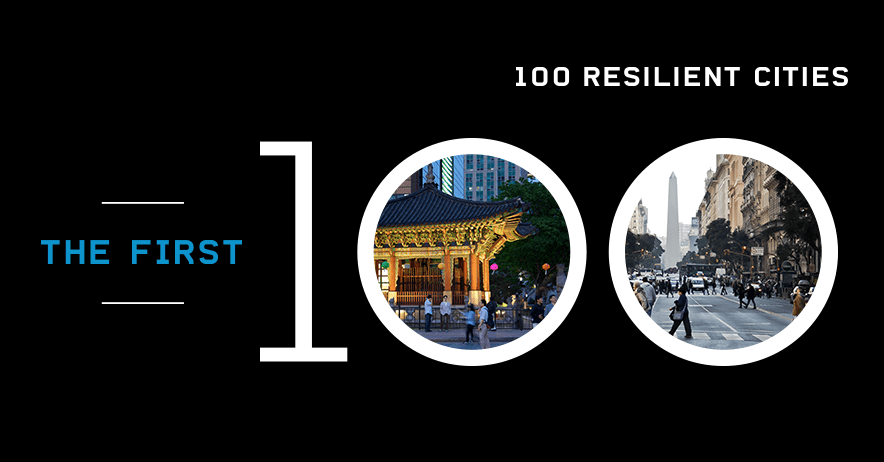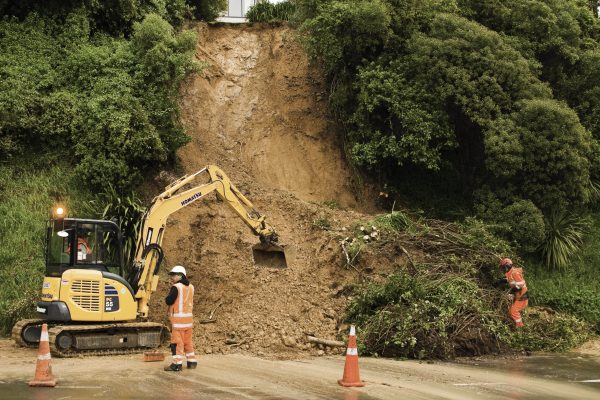Operationalising resilience: A heuristic framework for analysis
20/11/2018
ByProfessor Iain White, Professor Bruce Glavovic, Dr Judy Lawrence and Dr Gail Adams-Hutcheson
The question of how to build the resilience of places and organisations is attracting great interest. However, the term resilience is defined in diverse and contested ways. This raises important questions around how resilience is understood, what it is designed to achieve, and how this may translate into practice. The Resilience to Nature’s Challenges Operationalising Resilience project is examining what kinds of resilience are being delivered in Aotearoa New Zealand.
The concept of resilience encompasses three paths of action – to cope, adapt, or transform. Each of these may be necessary depending on the severity of stresses and shocks and the need for stability or change. Significantly, research shows that each of these objectives puts differing demands on our governance systems, from relatively simple policy changes to more complex and contested public processes that incorporate divergent values and a wide range of possible futures. Because of this, some types of resilience are not just easier to deliver than others, but governance processes and practices may also exert hidden pressures that favour stability outcomes over more challenging transformative measures.
The Operationalising Resilience project aims to use a heuristic framework to address the critical issues of resilience delivery and gauge the effect of governance processes on enabling or inhibiting differing resilience outcomes. Resilience governance is the range of governance interactions that enable society to navigate stresses and shocks in the face of complexity and contestation. It is an ongoing process of public decision-making and action to chart resilience development. The heuristic will help facilitate a distinctive ‘fit-for-purpose’ approach to resilience outcomes, helping us match and understand governance interactions to the types of problem faced, given the interplay of facts and values and how they shape with resilience outcomes.

The Resilience Governance heuristic shows that fit-for-purpose resilience governance varies according to the type of problem faced. It can be described as:
- Absorption: Competitive interactions can resolve simple and uncontested problems; and build absorptive capacity when stresses and shocks are mild and maintaining stability is the focus, e.g., private car insurance.
- State-led adaptation: Authoritarian interactions can address uncontested but technically complex problems; and build state-led absorptive capacity when stresses and shocks are moderate to severe, and maintaining stability or incremental change is required. An example is state-led relocation of people facing imminent danger due to a significant natural hazard.
- Network-based adaptation: Collaborative interactions can resolve relatively simple but politically contested problems; and build network-based adaptive capacity when stresses and shocks are mild to moderate, and flexibility and change are necessary. Collaborative planning processes to improve water resource management is a salient example.
- Transformation: Emancipatory interactions can address deeply complex and contested problems; and build transformative capacity when stresses and shocks are severe and systems require or undergo systemic change. Conventional modes of governance, and associated problem-solving approaches, are ill-equipped to deal with wicked problems. Governance innovations are therefore necessary, e.g., to transition from unsustainable fossil fuel dependency to climate resilient development pathways.
The heuristic can be used to examine what kind of governance interaction and associated decision-making responses might be best suited to address the resilience problem faced. In so doing, the links between resilience strategy, project goals and issues of concern can be critically reflected upon and addressed in a ‘fit for purpose’ manner.
The first phase of the Operationalising Resilience project looked at capturing a range of resilience policies, plans and projects that have been initiated across Aotearoa by focusing on strategies relating to Rockefeller 100 Resilient Cities in Wellington and Christchurch. This phase soon uncovered some pressing problems. First, many projects lacked a clear definition of what resilience is or might look like, consistent with the findings of the C2C Collaboration and Knowledge Sharing Network. Second, as existing institutions (Councils, government agencies, housing developers, community organisations) are designing the projects, there was a noticeable focus on creating data/indicators for monitoring risk. This, however, had the effect of steering projects down existing institutional structures/pathways and so we can see a focus on resilience as absorption over other forms of resilience. Third, the balance of the portfolio of responses tended towards economic objectives, such as with regard to business continuity or self-sufficiency to ‘cope’.

Some of the things we learned by tabling Wellington and Christchurch projects were:
- This work helps us look across the portfolio of resilience projects and understand who is privileged in policy more than others.
- Christchurch and Wellington resilience projects are a mix of initiatives that evolve over time, including projects centred on risk acceptance and management, adaptation, resilience building and recovery.
The second phase of the Operationalising Resilience project responds to and builds upon the outcomes of the scoping phase. Interviews will be conducted with governance actors from government, tangata whenua, civil society, the private sector, science, local and indigenous knowledge holders and media – including project proponents, stakeholders and other relevant governance actors and key informants. This will help us better understand how problems are framed, by whom, and the influences of governance networks on the types of resilience we are delivering, and what aspects of resilience governance need more attention. By analysing the impact of the ways we make decisions and the dimension of resilience we are focusing on, we can better match the most appropriate response to the type of problem being addressed.



